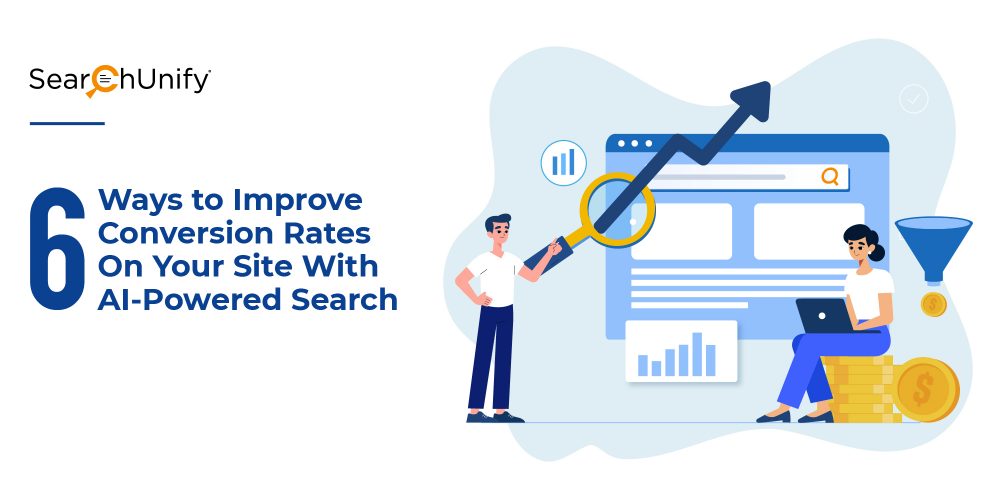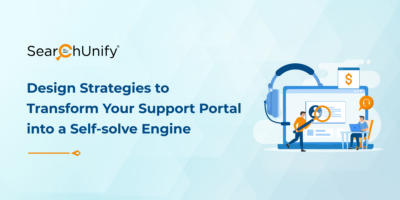
Conversions are directly proportional to search. The smarter the search engine, the better the conversion rates.
Whenever a visitor doesn’t find a relevant piece of information at your portal, they are likely to press the back button and look for the desired information at your competitors’ sites. So, every time you disappoint a visitor, you don’t just lose your credibility but also unleash a platform for your competitors to scale their business. Therefore, if used appropriately, on‑site search can be a significant tool to drive engagement and conversions.
According to a report by Forrester Research, 43% of visitors to a site go immediately to a search box, and searchers are 2‑3 times more likely to convert.
Most businesses understand that personalized and relevant search experiences are the way of the future; and many of them know that AI and cognitive technologies are the means. Since visitors leave digital footprints at each datapoint in the form of information they access, it is of paramount importance to leverage these important clues to understand your customers better. AI and cognitive technologies do exactly the same!
6 Ways to Leverage Cognitive Technology for Better Conversions
The majority isn’t sure how to deploy cognitive technology for the best optimization. If you also belong to the majority, then the following six ways would come in handy:
1. Change Your Game With the Search Box
More than 4 out of 10 visitors go right to the search box. Therefore, placing it at a spot where it is easily accessible is of utmost importance. Ideally, users expect it in the upper‑right or upper‑center area of your layout. Another concern with a search box is — sometimes users enter ridiculously generic terms — that further hampers the overall search experience.
Let’s say a visitor enters a search query “shoes”. Since the term is quite generic in nature, the search engine will fetch every product with the word “shoe” and swamp your screen with thousands of results, making it difficult for you to find the desired product. On the contrary, if you replace the query with “running shoes for women”, the SERP would be refined and the results would display just what you are looking for.
Therefore, train your search bar to prompt users to search well. Add prerequisites such as minimum character or minimum word requirements. You can also use the space inside a search box to explain to users what they can search for. It could be a simple text like “Search by keywords or item” or more specific text that hints at a retailer catalog like “Find anything for your workspace”.
2. Provide a 360‑Degree View of Site Offerings
More than often, a site offers an assortment of content, including blog, e‑Books, product guides, whitepapers, FAQs, etc. Therefore, your search box must be capable of crawling data from across all these content sources to produce the most relevant results.
AI‑powered search engines offer federated search that doesn’t just enable a comprehensive view of the site offerings but also allows users to find the desired results from the enterprise‑wide knowledge base. Simply integrate your multiple data repositories and make the content searchable anywhere you intend.
3. Leverage Insight Engines to Understand Your Visitors Better
Every time your visitors interact and engage with your brand, they leave behind digital footprints in the form of information they access or the browsing history. Insight engines and analytics leverage this data to help you understand your visitors better. Once you know your visitors better, you can customize SERPs according to their context and behavior to organically boost traffic.
You must also channelize the power of the insights engine to identify your top‑performing content and auto‑tune it for higher relevance to keep readers engaged and reduce bounce rates. Additionally, content‑heavy sites can identify content gaps with the help of an insights engine and bridge the gap by curating the required content for the site in order to fulfill the demands of regular visitors. By and large, search analytics is a godsend feature that helps you understand your visitors better and ensure higher conversion rates.
4. Enable Users to Organize Search Results
The quality of your SERP determines whether your users find what they are looking for in the blink of an eye or if they waste time perusing SERPs in search of the desired results — potentially increasing user frustration and bounce rates. There’s perhaps nothing more frustrating to a user than getting truckloads of search results and having to sift through the clutter.
Putting search into the hands of visitors helps you cut the noise. However, it demands a user‑friendly interface to let visitors narrow down precisely what they are looking for. Cognitive technology puts your visitors in the driver seat and lets them lead their experience by optimizing UI. It enables sorting and filtering by a variety of logical values, ensuring the results that are most relevant to the visitor’s intentions.
5. Enable Intelligent Autocompletion
Users expect you to know them, and one way to establish such a relationship is to enable autocompletion. It’s one of the most fundamental ways to provide an improved search experience as it reduces the workload for users by lending a helping hand in defining their search queries. By suggesting specific products or content, you help customers find alternatives to what they are looking for or even complimentary items that they hadn’t considered previously.
6. Terminate a ‘No Results Page’ At All Costs
A ‘no results page’ is such a turn off for visitors. So, terminate it at all costs from your portal. Deploy a fallback adapter so that even if you truly don’t have results to display, at least the visitor will be provided with a link to FAQ or ‘contact us’ page.
Semantics Is the Holy Grail of AI. Want to Know Why?
One of the prime ways to achieve search relevance is to understand the context of search queries irrespective of the choice of words used to formulate it. And this is exactly what semantic search does — it understands the context of queries and returns relevant results, improving the overall user experience; both before customers land on your site and while they are at it, which in turn leads to higher conversion rates. Here’s Your Comprehensive Guide to Semantic Search Engines, an eBook that will come in handy to educate you on all the whys and hows of semantic‑powered cognitive search. Download it for free now!



















